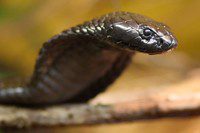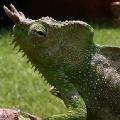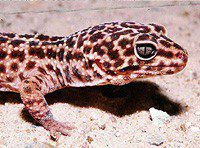
Spotted eublefar
This creature among terrariumists is known as the namesake of the leopard. Although only the name makes these animals related. In fact, we are talking about a leopard gecko or, as it is called in expert circles, a spotted gecko (Eublepharis macularius) – a lizard from the gecko family. This amazing animal is a popular and often found species in home terrariums, perhaps due to its natural friendliness and unpretentiousness in care. For its maintenance, it is enough just to equip a small terrarium. The spotted eublefar breeds easily in captivity. And although the lizard belongs to the primitive geckos, it, like some other representatives of this group, has real movable eyelids, which is reflected in the Latin name Eublepharis. And the second word Macularius refers to the spotted coloration of the lizard. Scientists distinguish two subspecies of spotted eublefars – nominal, that is, typical, and Afghan. However, there are three more subspecies, the relationship of which to the species of spotted eublefar has not been definitely proven.
Contents
Classification
Kingdom: Animals
Type: Chord
Class: Reptiles
Order: Scaly
Suborder: Lizards
Infraorder: Geckos
Family: Geckos
Род: Eublepharis
Species Eublepharis spotted (Eublepharis macularius), Leopard Gecko (English), Leopardgecko (German)
Appearance
 The appearance of spotted eublefars in nature and in captivity is noticeably different, probably because for many years this lizard has been subjected to active selection. But first, let’s dwell on the features common to all spotted eublefars. So, the main distinguishing feature is spotted coloring. Eublefara sizes are small, about 20 cm, and only occasionally there are large representatives – up to 30 cm. Another external property of these lizards, most likely due to the natural conditions of their habitat, is a rather thick and massive tail. The fact is that in the wild, spotted eublefaras live in an arid climate, and the tail is the place where they store moisture and food reserves. The lizards lose this organ very easily, but not by themselves, but more often for some external reason, for example, due to the careless handling of a person, but soon it grows back, however, it is no longer as thick and long as the original one. With abundant and regular nutrition, the tail of spotted eublefars becomes approximately equal in size to their body.
The appearance of spotted eublefars in nature and in captivity is noticeably different, probably because for many years this lizard has been subjected to active selection. But first, let’s dwell on the features common to all spotted eublefars. So, the main distinguishing feature is spotted coloring. Eublefara sizes are small, about 20 cm, and only occasionally there are large representatives – up to 30 cm. Another external property of these lizards, most likely due to the natural conditions of their habitat, is a rather thick and massive tail. The fact is that in the wild, spotted eublefaras live in an arid climate, and the tail is the place where they store moisture and food reserves. The lizards lose this organ very easily, but not by themselves, but more often for some external reason, for example, due to the careless handling of a person, but soon it grows back, however, it is no longer as thick and long as the original one. With abundant and regular nutrition, the tail of spotted eublefars becomes approximately equal in size to their body.
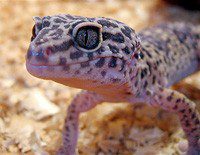 The head of the lizards is large, tapering in front and thus resembling a triangle. Their entire body is covered with small scales, on which pimples stand out here and there – separate cone-shaped scales, and on the chin the scales are larger, shielded. The paws of spotted eublefars are thin, of medium length with five elongated and rounded fingers, and under the front paws there are so-called armpits – leather pockets, the purpose of which scientists have not yet determined. Even spotted eublefaras have rather large bulging and elongated eyes, similar to a cat’s and protected from above and below by movable eyelids. As for coloration, in nature the general tone of the body of lizards is yellowish-gray with dark spots. These spots are located mainly on the upper body, on the sides, on the head and near the lips. And on the tail, besides them, there is a different pattern – wide transverse rings, which are more clearly developed in young animals.
The head of the lizards is large, tapering in front and thus resembling a triangle. Their entire body is covered with small scales, on which pimples stand out here and there – separate cone-shaped scales, and on the chin the scales are larger, shielded. The paws of spotted eublefars are thin, of medium length with five elongated and rounded fingers, and under the front paws there are so-called armpits – leather pockets, the purpose of which scientists have not yet determined. Even spotted eublefaras have rather large bulging and elongated eyes, similar to a cat’s and protected from above and below by movable eyelids. As for coloration, in nature the general tone of the body of lizards is yellowish-gray with dark spots. These spots are located mainly on the upper body, on the sides, on the head and near the lips. And on the tail, besides them, there is a different pattern – wide transverse rings, which are more clearly developed in young animals.
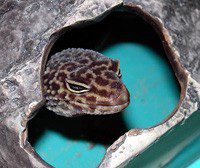 Breeding spotted geckos in captivity has led to the emergence of many variants of differently colored lizard forms. Today there are more than a hundred of them, and sometimes it is difficult to assume that all these geckos are of the same species. And what poetic names they have – Jungle, Banana, Dawn, Mandarin and even Snowstorm. Accordingly, there are completely white and black spotted geckos, yellow and red, brown and pinkish, with various patterns of spots and stripes, and sometimes completely monochromatic. The number of fans of spotted geckos continues to grow, and with it the emergence of new types of lizards.
Breeding spotted geckos in captivity has led to the emergence of many variants of differently colored lizard forms. Today there are more than a hundred of them, and sometimes it is difficult to assume that all these geckos are of the same species. And what poetic names they have – Jungle, Banana, Dawn, Mandarin and even Snowstorm. Accordingly, there are completely white and black spotted geckos, yellow and red, brown and pinkish, with various patterns of spots and stripes, and sometimes completely monochromatic. The number of fans of spotted geckos continues to grow, and with it the emergence of new types of lizards.
As for gender differences, they do exist. True, it is not so easy to distinguish a male spotted eublefar from a female. Of course, males have certain features, in particular a pair of noticeable swellings behind the cloaca – leathery folds in which the genitals are hidden, as well as yellow-gray wedge-shaped dots in front of the anus. Male spotted geckos are generally larger than females, and they also have a larger and more angular head. Of the subspecies, the Iranian eublefar is considered the largest, it is also longer-legged. Another subspecies – dark eublefar – has a yellow stripe on its back, uncharacteristic of other individuals.
Distribution and habitation
 Before the active breeding of these lizards began, spotted geckos lived in the warm climate of India and Asian countries such as Pakistan and Afghanistan, but mainly in their northern territories. Lizards are still found in the foothills of these areas. They generally like to climb higher, on rocky slopes, however, in such habitats there is almost no vegetation. But sometimes the spotted eublefar is also attracted by sandy soils, however, only not far in the deserts. At night, the lizard is awake, and during the day it hides in empty minks of rodents. The names of subspecies, as usual, indicate their ranges. The Iranian eublefar is a resident of the rocky foothill regions of Iran, the Turkmen is found there, as well as in Turkmenistan and on the territory of the Kopet-Dag mountain system. The dark eublefar is characteristic of the arid regions of India, and the most poorly studied subspecies lives there – Hardwick’s eublefar.
Before the active breeding of these lizards began, spotted geckos lived in the warm climate of India and Asian countries such as Pakistan and Afghanistan, but mainly in their northern territories. Lizards are still found in the foothills of these areas. They generally like to climb higher, on rocky slopes, however, in such habitats there is almost no vegetation. But sometimes the spotted eublefar is also attracted by sandy soils, however, only not far in the deserts. At night, the lizard is awake, and during the day it hides in empty minks of rodents. The names of subspecies, as usual, indicate their ranges. The Iranian eublefar is a resident of the rocky foothill regions of Iran, the Turkmen is found there, as well as in Turkmenistan and on the territory of the Kopet-Dag mountain system. The dark eublefar is characteristic of the arid regions of India, and the most poorly studied subspecies lives there – Hardwick’s eublefar.
Behavior and lifestyle
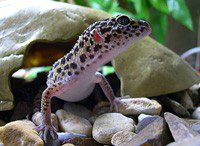 Spotted geckos live in the wild in small groups, in which the male leads, and with him several females. It is common for male lizards to guard their territory, protecting it from intrusion by other males. The life expectancy of this reptile is average: stronger males can live up to 8-10 years in nature, females a little less – 5-8 years, and fertile lizards rarely live up to 4 years. But in favorable artificial conditions, spotted eublefar can last up to 30 years. By the nature of activity, this lizard is rather a nocturnal animal.
Spotted geckos live in the wild in small groups, in which the male leads, and with him several females. It is common for male lizards to guard their territory, protecting it from intrusion by other males. The life expectancy of this reptile is average: stronger males can live up to 8-10 years in nature, females a little less – 5-8 years, and fertile lizards rarely live up to 4 years. But in favorable artificial conditions, spotted eublefar can last up to 30 years. By the nature of activity, this lizard is rather a nocturnal animal.
The main habits of spotted eublefars were determined by observing them in captivity. These reptiles show an amazing attachment to humans for lizards, over time they are even able to recognize their master among other people. Both in nature and in the terrarium, eublefars need some kind of shelter, for example, specially planted plants. Suitable air humidity is necessary for lizards to shed normally, they are prone to this. And the molting process itself is unusual. It starts with a change in skin color. At first, the spotted eublefar turns pale, gradually becoming snow-white, and then he rips off his old skin, under which you can see new bright scales. If there is enough moisture, then removing the dry skin is not difficult for the eublefar. Another interesting property of lizards is that they drink water like cats, lapping it with their tongues. Spotted geckos are incredibly clean. They learn to defecate in a certain place in the terrarium and never litter its entire territory. And if in nature lizards come out of hiding only at night, then in a terrarium they will be happy to bask under a light bulb all day long – spotted geckos love it. They, accustomed to a sultry climate that does not know drafts, need warmth all the time. In nature, they bask on stones that retain heat even at night, and in a terrarium they will have to be heated artificially. And yet, by the evening, even living within an artificial dwelling, the spotted eublefar perks up, examines the territory and regales itself with food with pleasure. But at night the lizard still falls asleep.
Food
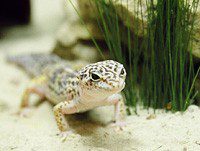 It is known about the nutrition of spotted eublefars in nature that these seemingly harmless lizards exhibit predatory instincts. They mainly hunt insects, but sometimes they are able to “feed” their own kind, only smaller relatives. And sometimes spotted geckos eat the offspring of other geckos. In a terrarium, it is also recommended to feed a reptile with insects, however, among them there are many exotic species, for example, various foreign cockroaches. Other options are crickets, grasshoppers, zoophobas and even occasionally newborn mice. On the issue of feeding the spotted eublefar with the most accessible mealworms, the opinions of zoologists differ. The main rule that everyone agrees with – both private owners and nursery owners – should not be given large insects to the lizard.
It is known about the nutrition of spotted eublefars in nature that these seemingly harmless lizards exhibit predatory instincts. They mainly hunt insects, but sometimes they are able to “feed” their own kind, only smaller relatives. And sometimes spotted geckos eat the offspring of other geckos. In a terrarium, it is also recommended to feed a reptile with insects, however, among them there are many exotic species, for example, various foreign cockroaches. Other options are crickets, grasshoppers, zoophobas and even occasionally newborn mice. On the issue of feeding the spotted eublefar with the most accessible mealworms, the opinions of zoologists differ. The main rule that everyone agrees with – both private owners and nursery owners – should not be given large insects to the lizard.
Here are some invertebrates that are especially tasty for the spotted eublefar: the marble cockroach, the Turkmen cockroach, which is even more beloved by lizards, and also the American cockroach – but you should be careful with it, there are aggressive individuals. Other suitable foods are brownie and banana crickets and darkling beetle larvae, but the latter should also be handled with care. Firstly, they contain a lot of phosphorus, which interferes with the absorption of calcium in the body of the spotted eublefar, and secondly, they can become something of a drug for the lizard. In food, spotted eublefars are unusually fastidious – they can not eat for weeks, and then pounce on any offered food, or, conversely, choose one food, completely refusing another. So the spotted eublefar can “get hooked” on the larvae of darklings. The recommended frequency of feeding the lizard is once a day or every other day, preferably in the evenings, when she herself shows the greatest interest in food. And you should not panic if the spotted eublefar suddenly refuses to eat for several days. For this, he has a tail, by which it is easy to determine the fatness of a lizard. All spotted eublefars, and especially females and young animals, should be supplemented with calcium powder.
Reproduction
Like many other animals with a pronounced attachment to the change of seasons, the breeding season for spotted eublefars comes after hibernation, in the period from February to April. Therefore, in order not to bring down their seasonal cycle, it is recommended to arrange artificial wintering for lizards even in terrariums. And what happens when it ends? Of course, mating begins. And it doesn’t matter whether heterosexual eublefaras met in the wild or were planted next to each other in a terrarium, here the lizards are distinguished by their special behavior. Male spotted eublefars, feeling the proximity of the “girl”, vibrate their tail and make a kind of crackling, and also behave quite aggressively towards females, not to mention rivals. Therefore, in the wild, each group of eublefars with one male at the head has its own territory, and in the terrarium, males are also recommended to be kept separately. The maximum that can be allowed is to plant one male along with several females.
But, one way or another, when mating has occurred, the time of laying comes. The female spotted eublefar arranges the first clutch in February, laying 3-4 pairs of eggs. Then, at intervals of a month, other clutches of approximately the same characteristics follow, and this can continue up to 10-13 times per season. But in captivity, more than 5 clutches should not be allowed so that the female is not exhausted. To preserve the eggs, females hide them in wet sand or other terrarium “litter”. Well, the incubation period directly depends on the ambient temperature. At 27°C it is about two months, at 30°C it is about one and a half. The temperature also affects the sex of the offspring of spotted eublefars. Females hatch at the same 27°C, and males at 30°C. In a terrarium, the clutch is usually placed in an incubator, and in the wild the female is next to her for some time. In addition, a pregnant spotted eublefar becomes especially voracious, and before laying itself, it begins to actively hide in shelters. When the offspring is born, then after 5 days its first molt begins, and after it you can begin to fully feed the young. A diet suitable for young spotted geckos will be confirmed by repeating their molt every two weeks.
Sources of
http://eublepharis.ru/
http://www.vitawater.ru
http://shkolazhizni.ru
http://ru.wikipedia.org/
http://www.bethowen.ru/
http://zooclub.by/
http://aboutreptilies.narod.ru
http://ru.wikipedia.org/
http://www.terraria.ru/



